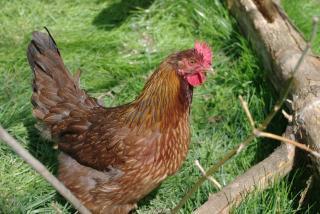Faykoko, could I use your Welsummers for our WCNA for hatchery birds comparison?......those are EXCELLENT examples!
The hatchery Welsummers are pitiful......take one look and keep on looking popped in my mind. I agree with most of Lester's judging but I would wait until about a year old to see what they look like. AFter all they are very young, gangly at that stage. I have the copy of the standard in the WCNA website. Even the breeder's bird is not the most perfect, there will be a fault or two but it is minor adjustments to their offsprings. White feathers are a no no otherwise if that is all you have to work with, cull HARD. It really is NOT recommended. See if you can find another roo.
The hatchery hen looks like a brown Leghorn stature in a Welsummer inside of it. Poorly colored. Her tail set is too high, if you can see her first tail feather sitting upright. It should have a 50 degree angle. Personally I think the breeder's hen is fine, well balanced and very nice color like she should have. She is something to have in my breeding flock.
Also I am seeing yellow eyes on the hatchery birds, a no no in the standard.
What I am seeing either rounded backs or cushion backs on hatchery Welsummers or pet backyard Welsummers with lineage unknown....its getting to be more and more common and it really irks me. Looks like those cushioned backs, those people are trying to make an Orpington out of them. That is not what we want, we want something that looks like a Welsummer.
There are breeders now are going for the standard of origin, we have the Americans (breed to American Standard of Perfection), then you have the UK (breed to the UK Standard of Perfection) and then there is the Dutch/Netherland/Holland (breed to the Netherland SOP). There is nothing wrong with breeding these if one wants to keep the originality of the Welsummers as it should be while others say, why change it if it works. Each nationality would have their own breeder's lines so that is something to look into because there are a few of us are changing in a different direction to keep the lines pure or cross them to see if it works.













